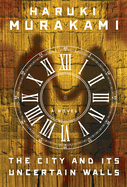
With The City and Its Uncertain Walls (translated from the Japanese by Philip Gabriel), Haruki Murakami returns to a world first created more than 40 years ago in a novella of the same title. That walled city will also be familiar to fans of the author's Hard-Boiled Wonderland at the End of the World, but prior familiarity is not required to appreciate the mesmerizing new fiction from the gifted and enigmatic Murakami (First Person Singular; IQ84; Wind/Pinball).
Part One opens as the young narrator describes walking barefoot with his girlfriend at the edge of a shallow riverbed, addressing the girl directly: "At that time neither you nor I had names.... The two of us sat there, side by side, on the riverbank of a nameless world." All of Part One uses this second-person address, the girl a constant presence in the story even as the narrator describes the way she one day disappears, leaving him confused and bereft. He goes on to college, gets a job, and maintains a comfortable existence into middle age. But the memory of the girl and the high-walled city they imagined together haunts him until the day he finds himself outside the wall, giving the Gatekeeper permission to remove his shadow and wound his eyes, allowing him to enter the city to work as a Dream Reader.
The City and Its Uncertain Walls plays with questions of reality and its construction. A confident ambiguity infuses each of the three distinct yet connected sections of the novel, evoking an uncanny, dreamlike state. For those willing to engage the ambiguities, Murakami's latest will not disappoint. --Sara Beth West, freelance reviewer and librarian

